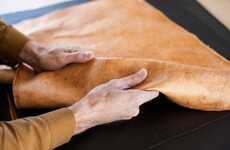
This Cozy Wool Alternative is Made from Leftover Animal Parts
Christopher Magsambol — August 13, 2015 — Eco
References: atsolutionssc & wired
Wendelin Stark and his team are currently perfecting a wool alternative material that can be used to create cozy winter apparel. Functional Materials Laboratory at ETH Zürich is working on using leftover animal material from carcasses -- that otherwise would be thrown out -- to extract the necessary materials for making clothing.
Stark's process turns unused skin, bones and ligaments of slaughter house animals into a basis for clothing. The gelatin extracted from these materials is put in a chemical bath and when dried and extracted, the material resembles wool. This extracted material later becomes the fiber needed to produce sweaters, mittens and hats.
Upon starting the project, Stark wanted to address two issues: the over-production of textiles, as well as discarded carcass waste. Through his innovative work, Stark's wool-like clothing can provide an extremely sustainable wool alternative.
Stark's process turns unused skin, bones and ligaments of slaughter house animals into a basis for clothing. The gelatin extracted from these materials is put in a chemical bath and when dried and extracted, the material resembles wool. This extracted material later becomes the fiber needed to produce sweaters, mittens and hats.
Upon starting the project, Stark wanted to address two issues: the over-production of textiles, as well as discarded carcass waste. Through his innovative work, Stark's wool-like clothing can provide an extremely sustainable wool alternative.
Trend Themes
1. Animal-based Sustainable Materials - Creating wool alternatives from leftover animal parts presents an opportunity for sustainable and eco-friendly material production.
2. Textile Recycling and Waste Reduction - Developing processes to transform discarded carcass waste into useful materials can help address the issue of over-production and reduce textile waste.
3. Circular Fashion Economy - Utilizing animal remnants to create clothing fibers promotes the concept of a circular fashion economy by making use of otherwise wasted resources.
Industry Implications
1. Textile Manufacturing - The textile manufacturing industry can explore the use of animal-based materials as a sustainable alternative to traditional wool production.
2. Fashion and Apparel - Fashion and apparel brands can incorporate wool alternatives made from leftover animal parts in their product lines, offering environmentally-friendly options to consumers.
3. Sustainable Agriculture - The sustainable agriculture industry can collaborate with material scientists to explore the potential of utilizing animal remnants for wool-like clothing production, reducing waste in the process.
2.6
Score
Popularity
Activity
Freshness























